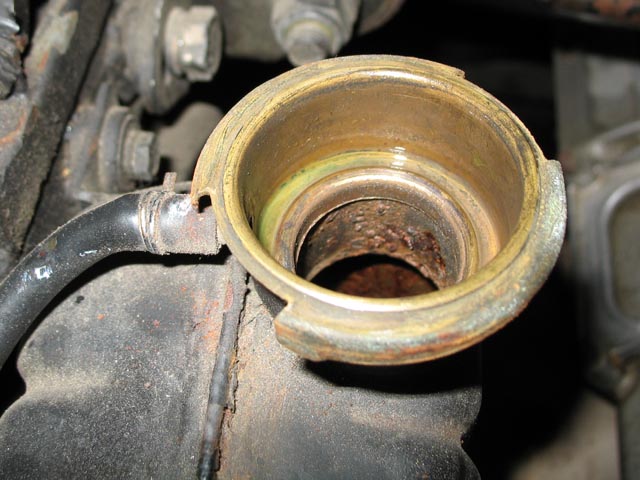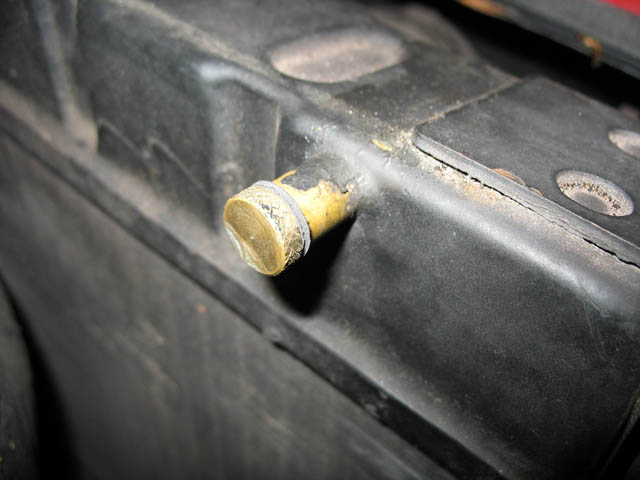
|
Many people have issues with their 308 "burping" coolant, the temperature fluctuating, overheating, and even hoses bursting as a direct result of not bleeding the cooling system correctly. When air is trapped in the cooling system, it expands a lot more than the coolant does when it gets hot. This causes the pressure to rise, which can burst a hose, squirt coolant out the expansion tank overflow hose or even cause the car to overheat. Not all cars overheat because of air in the system (some have bad radiators, bad thermostats or bad water pumps) but getting the cooling system properly bled makes the cooling system run cooler. Why is it tricky? The engine is in the back, the radiator is in the front, and there are long hoses running from the back to the front down low. This causes both the engine and the radiator to have a high spot, where they collect an air pocket. That's why there is a bleeder on the engine and another on the radiator. As well, the heating system has another high spot, but there are no bleeders on the heater cores. Getting the air out of them involves another step. Follow my 14 simple steps--it's easy! Even I can do it! This sounds tricky, but it's not. I'm just going into great detail here: 1. Park the car on level ground. (See? Easy! You can do that!)
2. If you are starting with an empty cooling system, such as one that you have just drained to replace the coolant, fill it through the expansion tank until it stops taking more coolant. Fill it all the way to the top of the tank, because the level will go down as you bleed. Keep in mind that a 308 with no coolant (i.e. fully drained) will take upwards of 6 gallons of coolant! There is a lot of plumbing to fill. Do not replace the expansion tank cap.
3. Open the bleeder screw on the radiator a couple turns until air comes out. (pic above) The bleeder is on the top right coner of the radiator (passenger side in a LHD car or drivers side in a RHD car). Please note that the bleeder screw has a tiny hole drilled in it to allow the air out when loosened. You do not need to completely remove the bleeder screw--just unscrew it a couple turns. If you remove it, you will have a hard time getting it back in when coolant starts squirting out of the radiator, especially if the coolant is hot! NOTE: The bleeder screw on the radiator ought to have a thin copper crush washer on it to seal. If it doesn't, you will end up having to crank it really tight to keep it from dribbling. You will eventually break the screw if that is the case. I find that replacing the copper washer with a neoprene rubber washer from the hardware store (as pictured above) seals a lot better and makes it so this thing stays closed with just finger tightness. 4. Now check the coolant level in the expansion tank. If it went down a lot, pour some more coolant in. Do not replace the cap. Remember that if the coolant in the expansion tank gets to the bottom of the tank, air may stop coming out of the radiator, even though there is more air in there. You need the coolant level in the expansion tank to force itself into the system.
5. Now you need to bleed the engine. The bleeder is located on the top of the thermostat housing, on the right side of the engine. On a carb car, it is annoyingly located right under the intake hose/airbox, and hard to open with the airbox in place.. On an injected car, it is a little easier to reach to the right of the plenum. Because the bleeder is on top of the housing, on the radiator side of the thermostat, you may not be able to get much air out until the engine is up to temperature and the thermostat opens. NOTE that this engine bleeder does not have a bleed hole drilled in it like the one on the radiator, and to get the best bleeding effect, you have to actually remove the screw. BE CAREFUL not to drop it. The best thing to do is to buy an ultra-cool EZBleed screw and never have this problem again! If you have a carb car and you want to have a prayer of bleeding the engine with the airbox in place, you need an EZBleed screw. 6. Replace the bleeder screw when no more air comes out. Keep in mind that you may not get much air out of this end with the cold engine and the thermostat closed. 7. Top off the coolant expansion tank. Do not replace the cap. 8. Start the car and turn the heat to full hot. 9. While the car is idling and warming up, bleed the front again. Hold a towel under the bleeder so that when the coolant dribbles out, it doesn't land on your radiator and make a mess. Don't bother with the rear bleeder. You need the thermostat to open first. 10. Once the radiator fans kick on, you know that the thermostat is open. Now bleed the front and rear again. When you bleed the rear, DO NOT remove the bleed screw all the way. Scalding hot water will come out, you will drop the screw and the washer and coolant will spew all over the engine. Unscrew the bleeder far enough that the air can escape around the threads. Once coolant starts sputtering around the threads, close it up. This is a terrible bleeder screw design and what you should really do is buy an EZBleed screw that works much better because it has a bleed hole drilled through it like the radiator bleeder. 11. Replace the expansion tank cap. 12. Go for a short drive around the block with the heater going full blast. It will be no fun at all getting baked in the car, but this jiggling gets all the rest of the air to collect in the high spots of the engine and radiator. Get the car good and hot. Having the heat on gets the air out of the heater hoses. A lot of air can get stuck in there. 13. Park the car on level ground and shut it off. The pressure in the system will allow you to bleed both ends again. Having the engine off makes it quiet enough to hear the air coming out. 14. The next time you go to drive the car, first check that you have enough coolant in the expansion tank before starting it. Then start it and wait until it reaches operating temp (after a drive, for example) and bleed both ends one more time. You should get a tiny bit more air out. Now are you done? No. Do it again the next time you drive the car. You will get a little more air out each time. After 3 drive/bleed cycles, you should have it all out. Yes, it's a pain, but once bled right, the sucker will run cooler! IF THE CAR DRIBBLES FROM THE
OVERFLOW |


